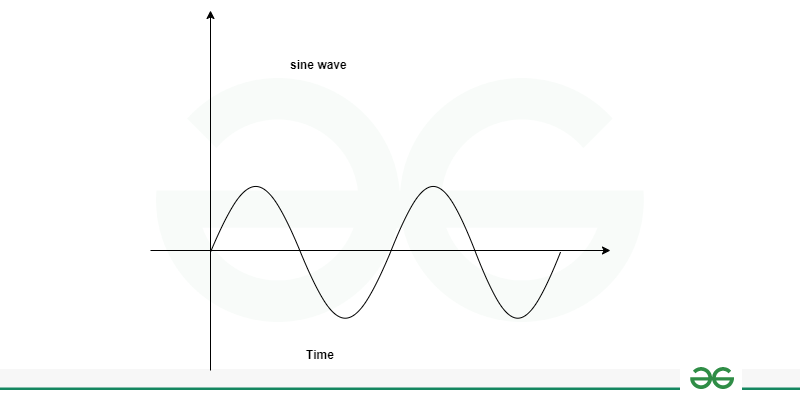Sinusoidal Signal
Last Updated :
27 Feb, 2024
Sinusoidal Signal is an important tool in the electronic industry. They are ubiquitous in modern electronics and are almost used in every daily appliance for input as Voltage, Current, and power amplifiers. In this article, we will study what a sinusoidal signal, how does it look like. We will also represent the Sinusoidal signal mathematically. Later we will discuss the need of having Sinusoidal signal and some applications of Sinusoidal Electronic Signal. We will conclude the article by summing up what we have learned. The electronics industry especially the communication system uses these signals in various circuits and readers can read about these other signals as well.
What is Sinusoidal Signal ?
Sinusoidal are the most smooth signals with no abrupt variation in their amplitude, the amplitude witnesses gradual change with time. Sinusoidal signals can be defined as a periodic signal with waveform as that of a sine wave. The amplitude of sine wave increase from a value of 0 at 0° angle to a maximum value of 1 at 90° , it further reaches its minimum value of -1 at 270° and then return to 0 at 360° . After any angle greater than 360° , the sinusoidal signal repeats the values so we can say that time period of sinusoidal signal is 2π i.e. 360°.
If we want to observe the variation in the amplitude of sinusoidal signal with varying angle, we can plot a graph as shown below.

sine wave
If we observe the graph, we can see that the amplitude varying gradually with a maximum value of 1 and a minimum value of -1. We can also observe that the wave begins to repeat its value after a time period or angle value of 2π hence periodicity of sinusoidal signal is 2π.
Primary Technologies of Sinusoidal Signal
Let us define some useful terms that are necessary for studying Sinusoidal signals. These are sinusoidal signal parameters:
- Graph: It is a plot used to depict the relation between quantities. Depending upon the number of variables, we can decide to number of axes each perpendicular to the other.
- Time period: The period for a signal can be defined as the time taken by a periodic signal to complete one cycle.
- Amplitude: Amplitude can be defined as the maximum distance between the horizontal axis and the vertical position of any signal.
- Frequency: This can be defined as the number of times a signal oscillates in one second. It can be mathematically defined as the reciprocal of a period.
- Phase: It can be defined as the horizontal position of a waveform in one oscillation. The symbol θ is used to indicate the phase.

Sinusoidal Signal
Mathematical Representation of Sinusoidal Signal
If we use mathematics to represent a sinusoidal function, we can represent a sinusoidal signal . We can take idea from the way that a normal sine wave is represented as sin(x)
If we consider a sinusoidal signal y(t) having an amplitude A, frequency f, and phase of quantity then we can represent the signal as
y(t)=A sin(2πft+ θ)
If we denote 2πf as an angular frequency ω the we can re-write the signal as
y(t)=A sin(ωt+ θ )
Sinusoidal Signal Analysis
Let us use mathematical tools like Fourier series to do analysis of Sinusoidal signal
Frequency domain analysis of sinusoidal waves
Among all of the mathematical tools used for analysis in engineering, frequency domain analysis is arguably the most convenient and useful. Frequency domain analysis refers to the steady state response of a system when subjected to a sinusoidal input. In frequency domain methods, the frequency of the input signal is varied over a certain range and study the resulting response.
Let us do the frequency domain analysis of a linear system which is subjected to a sinusoidal input.

Linear system
For an input r(t)= A sin((ωt) , the output of the linear system is:
c(t)=B sin(ωt + φ)
Hence we can say that when a sinusoidal input is fed to a linear system, the output generated is also a sinusoidal signal of the same frequency but different in magnitude and phase.
Fourier Analysis
Fourier analysis is a tool used in Signal Processing For the FT, both the time variable t and frequency variable ω are continuous-valued and vary from −∞ to ∞. The transform equations are
X(ω) = ∫x(t)e−jωt dt Forward transform
x(t) = 1/2π ∫ X(ω)ejωt dω Inverse transform
If X(ω) is the Fourier transform of a signal x(t) meaning x(t) is the inverse transform of X(ω)
x(t) ←→ X(ω)
x(t)= FT ←→ X(ω)
Using the above formula , we calculate the Fourier Transform of sin(ω0t)
F.T of sin(ω0t)= π/j[δ(ω − ω0) − δ(ω + ω0)]
Characteristics of Sinusoidal Signal
On studying the sinusoidal signal we can study some properties of sinusoidal signal as:
- Sinusoidal signals are periodic signals. This means that the amplitude value of signal begins to repeat after a fixed period of length i.e. time period. The periodicity of sinusoidal signal is 2π.
- A sinusoidal signal is an odd signal. This means signal that this signal is anti-symmetrical about the vertical axis . Mathematically a signal f(x) is said to be odd if f(–x) = –f(x).
- A sinusoidal signal is a continuous signal, this means that there are no breaking points in the graph of a sinusoidal signal. In other words, for a given finite amplitude range of the signal we find an infinite number of amplitude levels in between.
- Sinusoidal signal is a smooth signal and shows a gradual transition in its amplitude over the time. There is no abrupt change in amplitude values making sinusoidal signal an ideal choice.
- The amplitude of sine wave varies between the range -1 to 1 where both are inclusive therefore for a sinusoidal signal A sin(ωt) , the amplitude varies from -A to A.
Importance of Sinusoidal Signal
Sinusoidal signals are inevitably needed everywhere in electrical and electronics engineering, apart from this they are also used in researches related to physics. The sinusoidal signals are so crucial as performing mathematical operation like sum, subtraction, multiplication, differentiation, integration, etc. on a sinusoidal signal results in a sinusoidal signal.
Using Fourier Series Theory, it has been seen that a complex sinusoidal signal can be written in terms of simple sine and cosine signals. Thus, its mathematical analysis is easy making it the first choice for researchers because signals need analyzing in different electrical systems. A sine wave sinusoidal signal is ubiquitously used in transmission systems worldwide as it starts from zero value. Thus, all the electrical appliances are designed to work great on sine wave sinusoidal signal.
Applications of Sinusoidal Signal
Sinusoidal signal being an a signal of extreme importance has various applications in the electronics industry ,lets study some of them
- This signal is fed as an input signal to various electronic circuits. Since sinusoidal signals are smooth signals showing a gradual change in its amplitude, it is the best choice for input to various circuits in communication systems especially for AC- Alternating Current circuit.
- Sinusoidal signals can be used for representing various waveforms in physics. It can be used for demonstrating sound and light waveforms. Not only this, it is also used to depict some oscillatory motions like Simple Harmonic Motions(SHMs).
- The communication industry involves the sinusoidal signal where it is used for the transmission and reception of signals. These signals can be radio waves and microwave signals. These signals are also employed in amplitude modulation (AM) and frequency modulation (FM) as well.
- Sinusoidal signals are used in medical department , the MRI scanners used in hospitals has a sinusoidal RF pulse which is necessary for generating magnetic fields for imaging.
- It is used for transmitting and receiving signals in radar systems, earthquake analysis, navigation systems and feedback control system.
Conclusion
As we have seen that sinusoidal signals play an important role in modern electronics. We have already discussed the periodic nature of these signals along with other properties. As we discuss the uses of this signal we realize it is used in modulating signals and as an input signal to various circuits in communication system for various purposes. These applications signify the need to find appropriate methods to analyze sinusoidal signals. There are different methods we can use to analyze the signals and . There are various signals other than sinusoidal signals each used for a different purpose.
FAQs on Sinusoidal Signal
What is a non-sinusoidal signal?
A wave that cannot be describe as a function of sine wave is known as a non-sinusoidal wave. It is a non-continuous signal.
What are some real-life examples of a sinusoidal signal?
In real-life we can represent water waves and sound waves as sinusoidal signal since they are periodic and continuous signals.
What do you mean by periodicity of sinusoidal signal?
For any periodic signal, the value of the signal begins to repeat after a certain interval of time. This interval of time is called periodicity of the signal.
What is the range of sinusoidal signal?
As we observe the graph we can tell that the sinusoidal signal varies from -1 to 1 since sine wave varies as sin(x)⋿ [-1,1]
What is the period of signal y=sin 2x?
We know that time period for a signal y=sin x is 2π . Now if we change the input x to 2x then the time period will decrease by a factor of 2 i.e the time period for sin(2x) is 2π /2 i.e π
Share your thoughts in the comments
Please Login to comment...